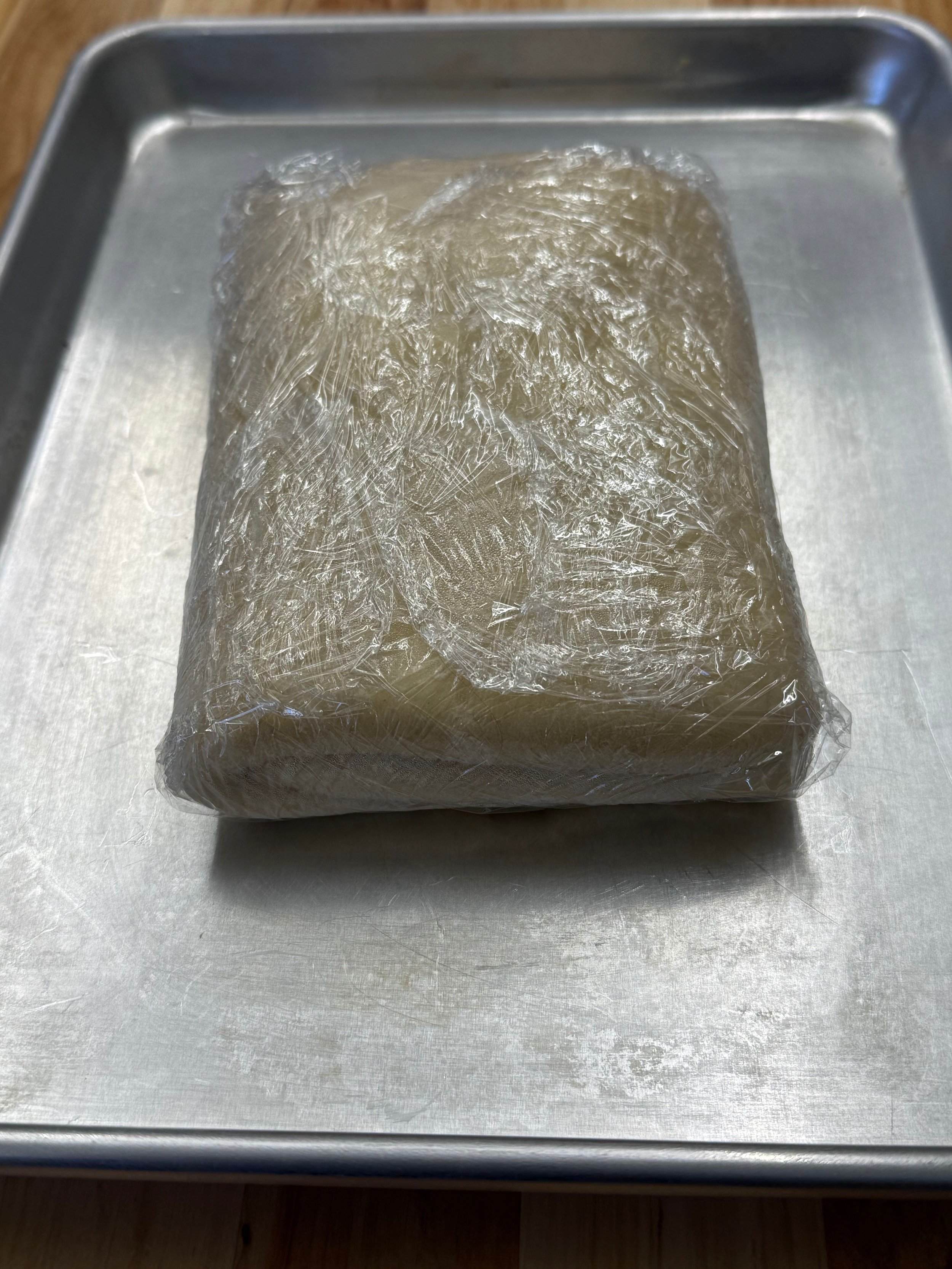Delicia Dorada
Delicia Dorada
Pastry Dough
Demo and Recipe Below!
At the family bakery, laminating doughs was always a labor of love. We didn’t have a dough sheeter back then. Every fold was done by hand, using nothing more than a rolling pin and a rhythm passed down by those maestros who came before us. It was demanding work, but it connected us to the craft in the most meaningful way.
That spirit is what inspired this month’s recipe. I purposely scaled the formula down to 250 grams of flour so that the lamination process remains accessible—something you can truly feel and experience without needing machinery. It’s small batch by design, preserving the artisan process.
And now, you can bring that experience into the comfort of your own kitchen. Whether you're rolling by hand on a countertop or folding with care on a cutting board, this recipe invites you to work with intention, just like we did at the bakery.
For a long time, I’ve wanted to infuse a signature flavor directly into the folds of a laminated dough and not just as a filling or topping, but into the layers themselves. This is our take on that idea. The pickled jalapeños bring heat, and the Monterey Jack cheese melts gently between the folds, creating buttery pockets of spice and richness. I call those flavor caves.
This cheese is as historical as it is functional. Before it became known as “Jack Cheese,” it was made by Mexican Franciscan friars in Alta California, during the era of New Spain. It was a mild, semi-soft cheese, deeply tied to the landscape and traditions of what we now call the Golden Coast. In the 1800s, a Scottish businessman named David Jack began selling it commercially in Monterey and the name “Monterey Jack” took off. It was an immediate hit, making this once-humble cheese widely accessible.
But for me, the roots run deeper. We used this cheese in our signature tamales de queso y rajas, in enchiladas, over chilaquiles, and even layered within sweet capirotada. Its versatility reflects the blending of Spanish, Indigenous, Mexican, and Californian cultures and family traditions that continue to shape our baking community today.
Since the trademark of this treat is the golden crust of a well-laminated bake, we thought it was fitting to call it a “golden delight,” in the oven and on your plate.
Whether you’re baking along or simply exploring, thank you for being here, your support helps keep these traditions alive and evolving.
Ingredients
Lamination & Filling
115 grams (1/2 cup or 1 stick) melted butter (for lamination)
57.5 grams (1/4 cup or 1/2 stick) melted butter (for brushing)
50 grams (1/4 cup) pickled jalapeños
30 grams (3 tablespoons) corn starch
25 grams (1/4 cup) Monterey Jack cheese, shredded
50 milliliters (1 large) egg (for egg wash)
Sesame seeds (optional)
Laminated Dough
250 grams (2 1/4 cups) unbleached all-purpose flour
60 milliliters (1/4 cup) water
25 milliliters (1 1/2 tablespoons) whole milk
50 milliliters (1 large) egg
10 grams (2 teaspoons) granulated sugar
10 grams (2 teaspoons) unsalted butter
7 grams (2 1/4 teaspoons) instant dry yeast
5 grams (1 teaspoon) salt
Equipment:
Electric stand mixer with paddle attachment to mix the dough
One plastic dough scraper and a rubber spatula
Handheld wire whisk
A digital scale with gram measurement capabilities
Pizza wheel for dividing and cutting into strips.
Pastry brush for butter application and basting technique for layers. Also used to brush the pastries when removing them from the oven
Pastry brush for egg wash.
Rolling pin or wooden dowel
2, ¼ sheet baking trays, or 1, ½ sheet baking trays
Parchment paper
Laminated Dough Procedure
Using a wire whisk, add yeast to the flour and mix. Set aside.
Warm the milk and water to reach about 90°F (32°C). Stir in sugar and pour into a mixing bowl.
Add the flour mixture over the liquid. Using the paddle attachment, mix for 1 minute on second speed.
Add egg and salt. Continue mixing for another minute.
Switch to the dough hook. Add 10 grams (2 teaspoons) of butter and mix for 12 minutes on second speed, or until smooth and elastic.
Final dough temperature should be around 78–80°F (26–27°C).
Cover and let the dough rest for 30 minutes at room temperature.
Lamination (Step 1)
Roll dough into a rectangle (18" x 8").
Brush entire surface with melted butter (from the ½ cup/115g portion).
The butter can be brushed in stages as it cools it will thicken.
Fold into thirds starting with the top portion.
Repeat the fold from the bottom like a letter or use a book fold.
Cover with plastic wrap and let rest for 30 minutes (room temp or refrigerate).
Lamination (Step 2)
Roll dough again into a 12" x 6" rectangle.
Repeat the fold (letter or book).
Rest the dough for another 60 minutes, covered.
Final Roll & Fill
Roll the dough out into a long rectangle.
Sprinkle the shredded cheese and diced jalapeños evenly across half the surface.
Fold the dough in half lengthwise and gently roll to bind the layers.
Chill the folded dough for 30 minutes to firm up.
Shape the Twists
Lightly roll the chilled dough to seal, then cut into 8 equal long strips.
Twist each strip by rotating the ends in opposite directions.
Give the twisted stands a 5 to 10 minute intermediate fermentation.
Shape each twisted strip into a snail (coiled) or figure-eight.
Final Proof & Bake
Place shaped pastries on a parchment-lined baking tray.
Let rest uncovered for 15 minutes.
Brush with egg wash and sprinkle with sesame seeds, if using.
Final proof for 60 minutes or until doubled in size.
Bake at 375°F (190°C) for 12–15 minutes or until golden brown.
Immediately brush with the reserved ¼ cup (57.5g) melted butter.
Serve warm for best texture and flavor.
More posts and recipes!
Alex Peña
“Baking is the most rewarding part of my culinary experiences.”
Subscribe
Get baking updates!





















